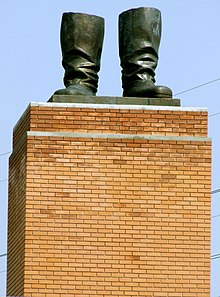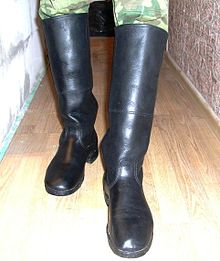Jackboot

A jackboot is a military boot such as the cavalry jackboot or the hobnailed jackboot. The hobnailed jackboot has a different design and function from the former type. It is a combat boot designed for marching. It rises to mid-calf or higher without laces and sometimes has a leather sole with hobnails. Jackboots have been associated popularly with totalitarianism, since they were worn by German military and paramilitary forces in the run-up to and during the Second World War. However they have been used officially prior and since by other nations as well, such as the United Kingdom, and had some civilian uses.[1]
Cavalry jackboot
[edit]The term originally denoted tall ‘winged’ leather cavalry boots, which were reinforced against sword blows by use of mail sewn into the lining of the leather.[citation needed] The ‘wings’ (backward projections) on these high boots particularly protected a rider's knee-joint from a sword blow. These boots are still worn and still so termed by the Household Cavalry regiment of the British Army, initiated during the 17th century. The term originates from the French word jaque meaning ‘coat of mail’.[2][3][4] These boots were made very heavy by the mail reinforcement but are slightly less heavy nowadays because modern materials are used as stiffeners. There are now few manufacturers of cavalry jackboots, the most famous being Schnieder Boots[5] of Mayfair, London, the official supplier to His Majesty the King's Household Cavalry.[6]
Hobnailed jackboot
[edit]

The second meaning of the term is derived from the first, with reference to their toughness, but is unrelated in design and function, being a combat boot designed for marching, rising to at least mid-calf, with no laces, sometimes a leather sole with hobnails, and heel irons.[7][8] The Germans term this boot Marschstiefel, meaning "marching boot". This is the classic boot used by the German infantry during World War I, though the stormtroopers dispensed with them in favor of laced boots of a type then used by Austro-Hungarian mountain troops.[9] An etymological source not derived from the cavalry jackboot has been suggested as from the word jack, jacket or jerkin, as a common garment worn by the peasantry.[10]
As a metaphor
[edit]
Totalitarianism
[edit]The boots are associated popularly with fascism, particularly Nazism, as they were worn by the Sturmabteilung and later the field forces of the Wehrmacht and Waffen-SS as part of the World War II German uniform before and even after Germany experienced leather shortages. When goose-stepping on pavement, the large columns of German soldiers in Marschstiefel ("marching boots") created a distinct rock-crushing sound which came to symbolize German conquest and occupation. A similar style of boot had been in use with German armies for World War I, the Franco-Prussian War, and before.

Jackboots were also associated with the armies of the former USSR (called sapogi) and East Germany. Jackboots are still a part of the modern parade and service attire of the armies of Russia and some other states.
The word is used often in English as a metonym and a synecdoche for totalitarianism, particularly fascism, although jackboots and similar types of footwear have been worn by various British regiments since the 18th century (see Wellington boot, origins).
In the United States in October 1993, the National Rifle Association (NRA) published a four-page advertisement in the center of its magazine American Rifleman, the first page of which showed goose-stepping, jackbooted legs under the question, "What's the First Step to a Police State?"[11] Two years later, the NRA's executive vice-president, Wayne LaPierre, created controversy when he referred to federal agents as "jack-booted thugs" in an NRA fund-raising letter. The term had been invented by United States Representative John Dingell, Democrat of Michigan, in 1981.[12] Such statements prompted former U.S. president George H. W. Bush to resign his membership in the organization soon afterward.[13]
See also
[edit]References
[edit]- ^ John Carr, The Stranger in France, or, A tour from Devonshire to Paris, (London 1803:32).
- ^ Longman Dictionary of Contemporary English
- ^ Chambers's Etymological Dictionary of the English Language
- ^ jaque in the Trésor de la langue française informatisé (The Digitized Treasury of the French Language).
- ^ Schnieder Boots website
- ^ Schnieder Boots website
- ^ dress Colonial America - Britannica Online Encyclopedia
- ^ Shoes: their history in words and pictures By Charlotte Yue, David Yue ISBN 0-395-72667-0, p. 43
- ^ Gudmundsson, Bruce, Stormtroop Tactics: Innovation in the German Army, 1914–1918, (New York: Praeger Publishing, 1989), 51
- ^ "Jack", 11th Edition of Encyclopædia Britannica
- ^ "What's the First Step to a Police State?". American Rifleman (Advertisement). National Rifle Association of America. October 1993.
- ^ Butterfield, Fox (May 8, 1995). "TERROR IN OKLAHOMA: ECHOES OF THE N.R.A.; Rifle Association Has Long Practice In Railing Against Federal Agents". The New York Times. Retrieved April 7, 2014.
- ^ Bush, George H. W. (3 May 1995). "Letter of Resignation Sent By Bush to Rifle Association". The New York Times. Retrieved 23 July 2015.
